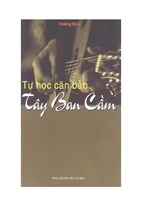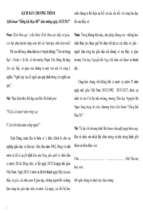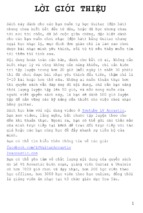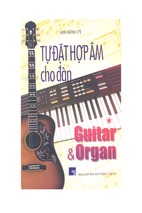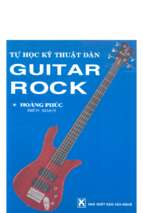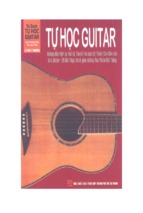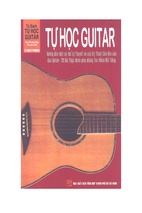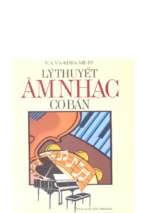Mô tả:
Triads Worksheet
www.pianogroove.com
So what is a triad?
A triad is a 3 note chord stacked in third intervals. The interval of a third is the basic building
block for chords Triads are the simplest of all chords and will most likely be the first chords
you will learn on the piano.
There of four different types of triad:
• Major Triads
• Minor Triads
• Diminished Triads &
• Augmented Triads
Now let’s look at each type:
Major Triads
Here are the major triads for C, G & D.
st
rd
th
In the first bar we have a C major triad. If we play the C major scale and take the 1 , 3 and 5 notes
of the scale we are left with a C major triad.
st rd
th
In the second bar we have a G major triad. If we play the G major scale and take the 1 3 and 5
notes of the scale we are left with a G major triad.
st rd
th
In the second bar we have a D major triad. If we play the D major scale and take the 1 3 and 5
notes of the scale we are left with a D major triad.
rd
rd
The interval relationship of all major triads is root, major 3 and then a minor 3 .
Minor Triads
Here we have the minor triads for C, G and D:
st
rd
th
First we have a C minor triad which is built from the 1 , 3 & 5 notes of the C minor scale.
st
rd
th
Next we have a G minor triad which is built from the 1 , 3 & 5 notes of the G minor scale.
st
rd
th
Next we have a D minor triad which is built from the 1 , 3 & 5 notes of the D minor scale.
rd
Another way of finding the minor scale is to play the major triad and drop the 3 by half a step.
rd
rd
The interval relationship of all minor triads is root, minor 3 and then a major 3 . Note that this is the
opposite interval relationship of major thirds
Here is an exercise for learning the 12 major & 12 minor triads:
rd
Start in the key of C and play a C major Triad. Now drop the 3 down half a step to play a C minor
triad.
rd
Next move the root up half a step and play a Db major triad. Now drop the 3 down half a step to
play a C# minor triad.
rd
Next move the root of the chord up another half step and play a D major triad. Now drop the 3
down half a step to play a D minor triad.
I’ll now continue this exercise up the chromatic scale. The chromatic scale by the way is all 12 notes of
the keyboard.
Notice how I said the chord name aloud each time I changed chord. This is very important as it
created an association between the shape, look and feel of the chord and it’s name.
Now let’s look at the other two types of triad:
Diminished Triads
Here are the diminished triads of C, G & D
Diminished chords use the circular symbol you can see next to the chord. They are also notated with
the abbreviation ‘dim’. These symbols are used interchangeably
rd
th
Diminished chords are constructed by playing the root, b3 and b5 of the major scale .
rd
th.
So in C, we play the major triad and then flat the 3 and 7
rd
th
We can do the same in G, major triad then flat the 3 & 7
Another way of looking at a diminished triad is a stack of minor thirds.
th
This is a very important triad to learn as you will find out when you watch the lessons of 7 chords.
th
We use the diminished triad to build 2 different 7 chords so it’s good to have the shape firmly under
your fingers.
Augmented Triads
Here are the augmented triads of C, G & D:
Augmented chords use the ‘plus’ symbol you can see next to the chord. They are also notated with
the abbreviation ‘aug’ and again these symbols are used interchangeably.
th
The augmented triad is the same as a major triad but with a sharp 5 . Sharp fifth simply means that
the fifth note has been raised by half a step.
Augmented triads are the least common of the four types of triads but you do still need to
understand how this chord is built.
When reading lead sheets, you may come across #5 chords which would look like this:
These are augmented chords so just remember that they are built from a major triad with a
th
sharpened 5
Inverting Triads
Next let’s look at changing the order of the notes of the triads – these are called inversions.
3 note chords can be inverted twice – here are the inversions in the key of C major. When the root is on the
bottom, we call this root position.
st
Next we have the 1st inversion. To get from root position to 1 inversion, we take the bottom note of the chord
and move it to the top. Notice that this chord sounds different even though we are playing the same notes.
st
nd
Next we have the second inversion. To get from the 1 to the 2 inversion, again we take the bottom note and
nd
move it to the top – again notice how this sound different. We could also find the 2 inversion from root position
by taking the top note and putting it on the bottom.
Now let’s do the same for C minor.
You need to learn to play the inversions of triads in all 12 major and minor keys.
Arpeggiating Triads
Once you are comfortable with the inversions it’s time to start arpeggiating the triad shapes up and
down the keyboard. Mastering this exercise will help you when you come to improvise.
Let’s start in C major and arpeggiate the triads through the different inversions
Now let’s switch to C minor and repeat the exercise.
We can do the same thing in D, then G and so on… You will want to do this in all keys around the
circle of fifths.
So how to practice these exercises
Mastering these exercises is a gradual process – don’t try to go through all 12 keys in 1
practice session if you are just starting out.
The trick is to start your practice with 2 or 3 keys and then next time pick 3 different keys
and keep going until you’ve mastered all of them.
Also make sure you pick the right tempo to do these exercises – if you play too fast you will
lose accuracy and it becomes a pointless exercise.
Remember to start slow and gradually build up the speed.
- Xem thêm -





